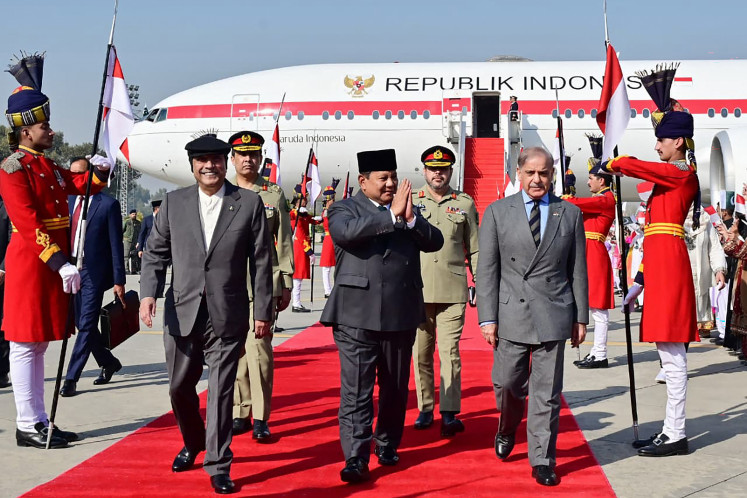Popular Reads
Top Results
Can't find what you're looking for?
View all search resultsPopular Reads
Top Results
Can't find what you're looking for?
View all search resultsHCV concept at stake
Indonesia has set aside 22
Change text size
Gift Premium Articles
to Anyone
I
ndonesia has set aside 22.8 million hectares of conservation area in the form of national parks and reserves; however, the effectiveness of the management protecting these reserves and forests remains unproven. Deforestation has been unchecked, and occurs even in areas that have high value and vulnerable ecosystems, such as heath forest, peat swamp forest or endangered species habitat.
As such, promoting high conservation value (HCV) in production areas will complement what is currently being implemented by the government. The concept of HCV emerged in 1999 as Principle 9 of the sustainable forest management standards developed by the Forest Stewardship Council (FSC).
Although the HCV concept was originally designed for management of natural production forests, the concept rapidly gained popularity in other production contexts such as industrial timber plantations and oil palm development. HCV assessment is a requirement for certification processes, i.e. Roundtable Sustainable Palm Oil (RSPO) and Indonesian Sustainable Palm Oil (ISPO) certifications for oil palm plantations and FSC for natural forest management and pulp plantation certification.
At present, there are 450 management units ' covering natural forest production, pulp plantation and oil palm plantation areas ' that have defined and are managing their HCV areas. In total, more than 500,000 hectares of production area have been identified and designated as HCV areas
The HCV determination is very crucial to strengthen life supporting systems in management units and landscape levels (watershed areas), as part of a precautionary approach to prevent catastrophes due to natural resource exploitation, such as land and forest fires, water scarcity, pests, etc.
Unfortunately, the benefits are often not perceived by concession owners due to their generally short-term commercial perspectives. The HCV areas are often defined half-heartedly, considered as green business campaign strategy rather than the truth business needs.
A fundamental shift of the mindset of concession owners is needed to see HCV as a source of revenue rather than costs, so that HCV is no longer seen as a threat to the profitability of concession areas.
The HCV areas among management units must be connected to one another to form conservation corridors that are able to facilitate germplasm and wildlife movement among the remaining (semi) natural upstream and downstream habitat areas.
In the real world, the HCV areas are mostly discrete, like small islands in the sea of intensive production area. This leads to the failed function of HCV as the last resort of landscape-wide conservation initiatives. The role of government is required to ensure the connectivity of HCV areas among concession boundary areas.
In that case, prior to the issuance of concession areas permits, the government should ideally develop a landscape conservation planning map to delineate HCV areas as natural corridors on a landscape level. This can function as a spatial planning for HCV areas that can be used as a mandatory reference for the concession area units.
At present, the characteristics of the delineation of HCV areas are highly dependent on the work ethic of the HCV area consultants and the diverse perceptions of the HCV concept. As an example of the latter issue, there is persistent debate over whether HCV areas should allow 'land sharing', i.e. that development activities can be undertaken in a manner that ensures the maintenance of conservation values, or that it must imply 'land sparing', i.e. that the HCV areas must be exclusively dedicated to conservation where development is forbidden.
The existence of HCV consultant accreditation bodies is required, while HCV-Network Indonesia (HCV-NI) should be revitalized as a platform to reconcile the diverse perceptions.
The status of HCV implementation on the ground should be monitored by management unit stakeholders, including the neighboring management units that live on the same landscape; however, this is still hard to implement, due to lack of awareness from governments, private companies and other development agents on the importance of the HCV issue.
Another challenge to HCV implementation is the difference in HCV principles between the RSPO and ISPO certifications. The RSPO uses national law and regulation and global initiatives as reference for HCV areas delineation, while the ISPO fully refers to Indonesian law and regulations on protected areas. The RSPO surveillance is undertaken every two years, while ISPO takes place every five years in conjunction with the revised spatial planning at district, province and national level.
To address the above problems, strong collaborative and synergetic actions are required among three main HCV stakeholder groups: first, NGOs, certification bodies, universities, the Association of Indonesian Forest Concessionaires Holders (APHI) and the Indonesian Palm Oil Producers Association (GAPKI) to refine the guidelines, or toolkits, of HCV assessment, management and monitoring systems; second, the government and local sustainable development agents to monitor the status of HCV areas; and third, the concession owners, who need to see HCV as a long-term ecological and social investment to sustain their business.
If those parts do not work together, the HCV issue will only benefit free-riders and there will be no contribution to save high conservation importance and the development of nature conservation measures in this country.
The writer is director of the Tropenbos International-Indonesia Program.










